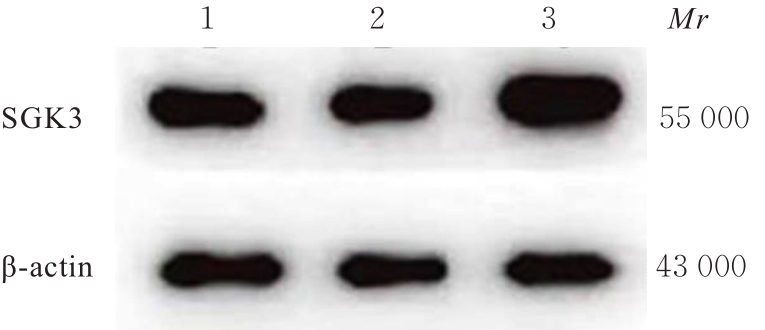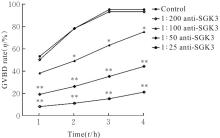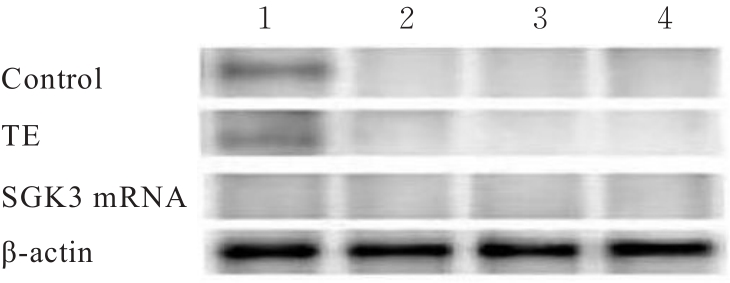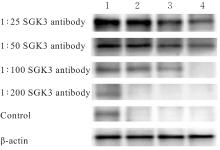Journal of Jilin University(Medicine Edition) ›› 2024, Vol. 50 ›› Issue (4): 891-899.doi: 10.13481/j.1671-587X.20240402
• Research in basic medicine • Previous Articles Next Articles
Effect of SGK3 on recovery of first meiotic division of oocytes in mice and its mechanism
Wenxiu GUO1,Yan ZHUANG1,Huiling ZHANG1,Wenning HE1,Jun MENG2( )
)
- 1.Department of Clinical Laboratory Diagnosis,Inner Mongolia Medical University,Hohhot 010059,China
2.Department of Clinical Laboratory,Affiliated Hospital,Inner Mongolia Medical University,Hohhot 010050,China
-
Received:2023-08-05Online:2024-07-28Published:2024-08-01 -
Contact:Jun MENG E-mail:nmfrank@163.com
CLC Number:
- Q132
Cite this article
Wenxiu GUO,Yan ZHUANG,Huiling ZHANG,Wenning HE,Jun MENG. Effect of SGK3 on recovery of first meiotic division of oocytes in mice and its mechanism[J].Journal of Jilin University(Medicine Edition), 2024, 50(4): 891-899.
share this article
| 1 | LEE D Y, LEE H H, LEE J R, et al. Effects of cyclic adenosine monophosphate modulators on maturation and quality of vitrified-warmed germinal vesicle stage mouse oocytes[J]. Reprod Biol Endocrinol, 2020, 18(1): 5. |
| 2 | JIA B Y, XIANG D C, SHAO Q Y, et al. Inhibitory effects of astaxanthin on postovulatory porcine oocyte aging in vitro [J]. Sci Rep, 2020, 10(1): 20217. |
| 3 | WANG Q, WEI H J, DU J, et al. H3 Thr3 phosphorylation is crucial for meiotic resumption and anaphase onset in oocyte meiosis[J]. Cell Cycle, 2016, 15(2): 213-224. |
| 4 | LAMOTHE S M, ZHANG S T. The serum- and glucocorticoid-inducible kinases SGK1 and SGK3 regulate hERG channel expression via ubiquitin ligase Nedd4-2 and GTPase Rab11[J]. J Biol Chem, 2013, 288(21): 15075-15084. |
| 5 | SUNADA S, SAITO H, ZHANG D D, et al. CDK1 inhibitor controls G2/M phase transition and reverses DNA damage sensitivity[J]. Biochem Biophys Res Commun, 2021, 550: 56-61. |
| 6 | SMITS V A, MEDEMA R H. Checking out the G2/M transition[J]. Biochim Biophys Acta, 2001, 1519(1/2): 1-12. |
| 7 | ZHANG Y, ZHANG Z, XU X Y, et al. Protein kinase A modulates Cdc25B activity during meiotic resumption of mouse oocytes[J]. Dev Dyn, 2008, 237(12): 3777-3786. |
| 8 | PARK J, LEONG M L, BUSE P, et al. Serum and glucocorticoid-inducible kinase (SGK) is a target of the PI 3-kinase-stimulated signaling pathway[J]. EMBO J, 1999, 18(11): 3024-3033. |
| 9 | BASNET R, GONG G Q, LI C Y, et al. Serum and glucocorticoid inducible protein kinases (SGKs): a potential target for cancer intervention[J]. Acta Pharm Sin B, 2018, 8(5): 767-771. |
| 10 | HOSODA E, HIRAOKA D, HIROHASHI N, et al. SGK regulates pH increase and cyclin B-Cdk1 activation to resume meiosis in starfish ovarian oocytes[J]. J Cell Biol, 2019, 218(11): 3612-3629. |
| 11 | YANG Z F, ZHANG M L, ZHANG J, et al. MiR-302a-3p promotes radiotherapy sensitivity of hepatocellular carcinoma by regulating cell cycle via MCL1[J]. Comput Math Methods Med, 2022, 2022: 1450098. |
| 12 | YUAN Y P, ZHAO H, PENG L Q, et al. The SGK3-triggered ubiquitin-proteasome degradation of podocalyxin (PC) and ezrin in podocytes was associated with the stability of the PC/ezrin complex[J]. Cell Death Dis, 2018, 9(11): 1114. |
| 13 | PENG L Q, ZHAO H, LIU S, et al. Lack of serum- and glucocorticoid-inducible kinase 3 leads to podocyte dysfunction[J]. FASEB J, 2018, 32(2): 576-587. |
| 14 | LIU J L, YU X Y, YU H Y, et al. Knockdown of MAPK14 inhibits the proliferation and migration of clear cell renal cell carcinoma by downregulating the expression of CDC25B[J]. Cancer Med, 2020, 9(3): 1183-1195. |
| 15 | CUI C, REN X L, LIU D J, et al. 14-3-3 epsilon prevents G2/M transition of fertilized mouse eggs by binding with CDC25B[J]. BMC Dev Biol, 2014, 14: 33. |
| 16 | LANG F, VOELKL J. Therapeutic potential of serum and glucocorticoid inducible kinase inhibition[J]. Expert Opin Investig Drugs, 2013, 22(6): 701-714. |
| 17 | FIRESTONE G L, GIAMPAOLO J R, O’KEEFFE B A. Stimulus-dependent regulation of serum and glucocorticoid inducible protein kinase (SGK) transcription, subcellular localization and enzymatic activity[J]. Cell Physiol Biochem, 2003, 13(1): 1-12. |
| 18 | 冯少青, 孟 峻. 血清和糖皮质激素诱导蛋白激酶3与肿瘤发生发展关系的研究进展[J]. 吉林大学学报(医学版), 2022, 48(2): 540-545. |
| 19 | CRISTOFANO A D. SGK1: the dark side of PI3K signaling[J]. Curr Top Dev Biol, 2017, 123: 49-71. |
| 20 | NALAIRNDRAN G, HASSAN ABDUL RAZACK A, MAI C W, et al. Phosphoinositide-dependent kinase-1 (PDPK1) regulates serum/glucocorticoid-regulated kinase 3 (SGK3) for prostate cancer cell survival[J]. J Cell Mol Med, 2020, 24(20): 12188-12198. |
| 21 | HUO Q Y, XU C, SHAO Y H, et al. Free CA125 promotes ovarian cancer cell migration and tumor metastasis by binding Mesothelin to reduce DKK1 expression and activate the SGK3/FOXO3 pathway[J]. Int J Biol Sci, 2021, 17(2): 574-588. |
| 22 | WANG Y Z, ZHOU D J, CHEN S. SGK3 is an androgen-inducible kinase promoting prostate cancer cell proliferation through activation of p70 S6 kinase and up-regulation of cyclin D1[J]. Mol Endocrinol, 2014, 28(6): 935-948. |
| 23 | XU L S, XIONG F, BAI Y Y, et al. Circ_0043532 regulates miR-182/SGK3 axis to promote granulosa cell progression in polycystic ovary syndrome[J]. Reprod Biol Endocrinol, 2021, 19(1): 167. |
| 24 | 周嘉禾, 陈志静, 李洁明, 等. PGRMC1在多囊卵巢综合征患者中的表达及其调控卵巢颗粒细胞凋亡和糖脂代谢的分子机制[J]. 中南大学学报(医学版), 2023, 48(4): 538-549. |
| 25 | OCHI H, AOTO S, TACHIBANA K, et al. Block of CDK1-dependent polyadenosine elongation of Cyclin B mRNA in metaphase-i-arrested starfish oocytes is released by intracellular pH elevation upon spawning[J]. Mol Reprod Dev, 2016, 83(1): 79-87. |
| [1] | Huiling ZHANG,Di HAN,Wengxiu GUO,Haiyao PANG,Jun MENG. Regulatory effect of SGK1 on oocyte cleavage in fertilized eggs in mice at G1 stage mediated by Cyclin B/Cdc2 pathway and its mechanism [J]. Journal of Jilin University(Medicine Edition), 2024, 50(3): 628-637. |
| [2] | Wenning HE,Shaoqing FENG,Haiyao PANG,Jun MENG. Dynamic expressions and subcellular localization of SGK3 mRNA and protein in oocytes of mice at different stages [J]. Journal of Jilin University(Medicine Edition), 2023, 49(5): 1210-1216. |
| [3] | Haiyao PANG,Li HOU,Wenning HE,Jun MENG. Expression levels of serum and glucocorticoid-induced protein kinase 3 in one-cell stage fertilized eggs at different cell cycles in mice and its subcellular localization [J]. Journal of Jilin University(Medicine Edition), 2023, 49(4): 884-889. |
| [4] | LIU Lanqing, LI Ruilin, ZHOU Xiaomin, MENG Jun. Dynamic expression and localization of CDC14B in each cell cycle of mouse one-cell fertilized eggs [J]. Journal of Jilin University(Medicine Edition), 2020, 46(04): 675-679. |
| [5] | WANG Xinmeng, LI Qiyang, LIU Chao, XIAO Jianying. Effects of microspherule protein 1 on invasion and migration of gastric cancer cells and their mechanisms [J]. Journal of Jilin University(Medicine Edition), 2019, 45(02): 251-257. |
| [6] | LIU Chao, REN Lili, LUAN Zhidong, MENG Zhichao, LIU Yimeng, XIAO Jianying. Screening of candidate molecules interacting with protein kinase Wee1B from human ovary cDNA library and its regulation effect [J]. Journal of Jilin University Medicine Edition, 2016, 42(05): 866-871. |
| [7] | LIU Chao,XIAO Jian-ying,REN Li-li,LIU Yang,MA Jun-ren,YU Bing-zhi. Expression and localization of protein kinase Wee1B in mouse one-cell-stage embryos [J]. Journal of Jilin University Medicine Edition, 2013, 39(5): 863-867. |
| [8] | ZHANG Xiao-mei,FANG Liao-qiong,WANG Zhi-biao. Preparation of mouse fibroblast feeder layers and establishment of embryonic stem cell lines of C57BL/6 mice [J]. J4, 2012, 38(6): 1081-1085. |
| [9] | LIU Chao,REN Li-li,LIU Yang,XIAO Jian-ying . Promotion of protein kinase CK2β siRNA in early development of fertilized mouse eggs [J]. J4, 2012, 38(4): 678-682. |
| [10] | LIU Chao, MENG Zhichao, REN Lili, LIU Yimeng, GUO Miao, SUN Yiya, XIAO Jianying. Inhibitory effect of protein kinase Pkmyt1 on development of one-cell-stage mouse embryos [J]. Journal of Jilin University Medicine Edition, 2015, 41(01): 16-20. |

























